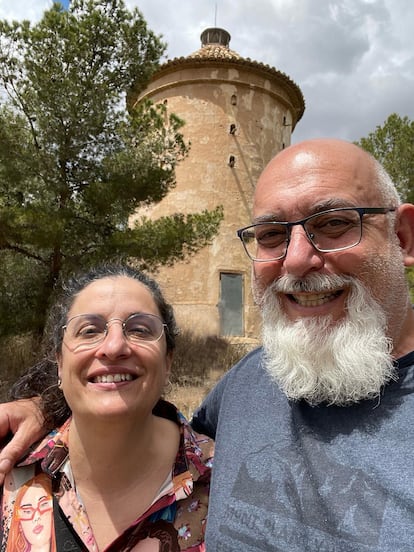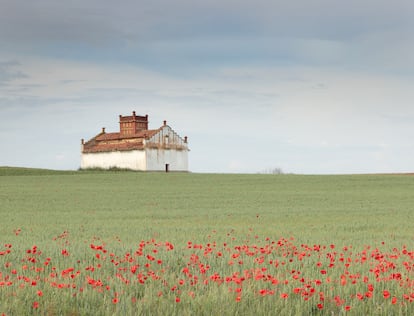A pigeon flock lifts the flight. Beating its wings is a deaf applause suspended in the wind. Where do they come from and, above all, where are they going? When the night falls, where do you dream your dreams? These birds sleep where they can, under the bridges, in cornices and in cavades of walls; In the field, in trees and escarpes. Only some do it in the Palomares, a traditional type of construction that is gradually lost. In its dissemination and conservation, the Leonesa has been committed for 15 years – although born in Switzerland – Irma Basarte Diez (Zurich, 55 years old) who, together with the photographer José Benito Ruiz Limiñana, has published Singular Palomares of Spain (Fine Art Editions). In this book, divided into two volumes, there are hundreds of photographs of some of the almost three thousand dallomars that Irma Basarte and José Benito Ruiz have visited and geolocated, including ruins and remains. Through a QR code you can follow your steps on a map, from palomar in Palomar.
“The palomars were very hungry in this country. Then, especially since the sixties, which is when the people of the villages migrate to the cities, they begin to abandon themselves. If there are no hands that take care of the earth, because to take care of pop Because, with water, the doves are coming down, since most are mud, ”says Basarte. In addition to fighting hunger, with the raising of pigeons and pigeons, the dove the down and the popcorn took advantage of, the excrements of these birds, which served as payment for the crops, to tanch skins and for the manufacture of gunpowder.
There are popcorn in castles and convents, in solar houses and in the Pazos de Galicia, where it is said: “If you have a chapel, dove and cypress, Pazo is.” There are popcorn in the fields of work of Spain, but also in many cities. Basarte claims urban doves, even being aware of the problems that usually occur in cities with these birds. “In the cities there have been popcorn all their lives. Some restore them, they leave them beautiful, and they close them to the pigeons. That makes no sense,” he says. And it emphasizes: “Palomares are, together with the hives, the only constructions in which animals enter and come free.” When asked about her favorite dove, the answer comes out immediately, because it is the origin of this winged passion: it is the dove that she and her husband restored in the town of this, holy Martas, in León, and then filled with pigeons. It was the beginning of the Association of Friends of Los Palomares and the beginning of his dissemination work.
In those first steps a name stands out: Casado Concha. Leonese’s philologist and ethnographer had worked in the Department of Ethnography of the Higher Council for Scientific Research (CSIC), in Madrid, and after his retirement he began a work of recovery and dissemination of traditional culture in León. Casado participated in the creation of several museums, such as Alfarmuseo, in Jiménez de Jamuz (León), dedicated to pottery; The Museum of Arriería, in Santiago Millas, and the Batán Museo de Val de San Lorenzo, destined to the knowledge of textile crafts. “Concha Casado was the president of honor of the association. Well, it still is. She was a very intelligent woman, very cast. “When I went to know her, I was eighty -and -year -old. I think this would go differently. ”

Among the most unique popcorn in Spain is that of Huerta Noble, in La Redondela (Huelva), which is considered the largest in Europe. It was built in the 18th century, it has about 36,000 Nidales and has been declared a cultural interest. Another of the largest is the one located in the Natural Park of La Breña and Marismas del Barbate, in Cádiz. The uniqueness of both is that the nest are made with pottery of pottery. In Asturias, doves are usually built in stone. In Castilla y León there are mud doves, especially by land of fields, but in other territories of that autonomous community they are made of stone. In La Rioja there are some in Cuevas, excavated in the rock, such as the Palomares Rock Set, in Nalda. “There are popcorn in all provinces. For example, in the Tabernas desert, in Almería. And we have found doves in curious places, as one in a cemetery, in Paramos, A Coruña. When the cemetery was extended, the palomar was respected,” says Basarte.
The Friends of Los Palomares association considers that their work is not over, because there are still many unique doves to discover and geolocalize. For the maintenance of these constructions, Basarte believes fundamental that the restorations made by individuals are supported. “There has to be aid of the administrations so that whoever wants to restore their family dove, or whoever has, can do it. The Leon Institute of Culture has been taking out aid for the restoration of palomars for more than thirty years and we know that other provinces also have similar aids or they are approving them. There are a little bit of hope, since in their twenty years many of the palomars will only remain in the books, because half will no longer exist.


